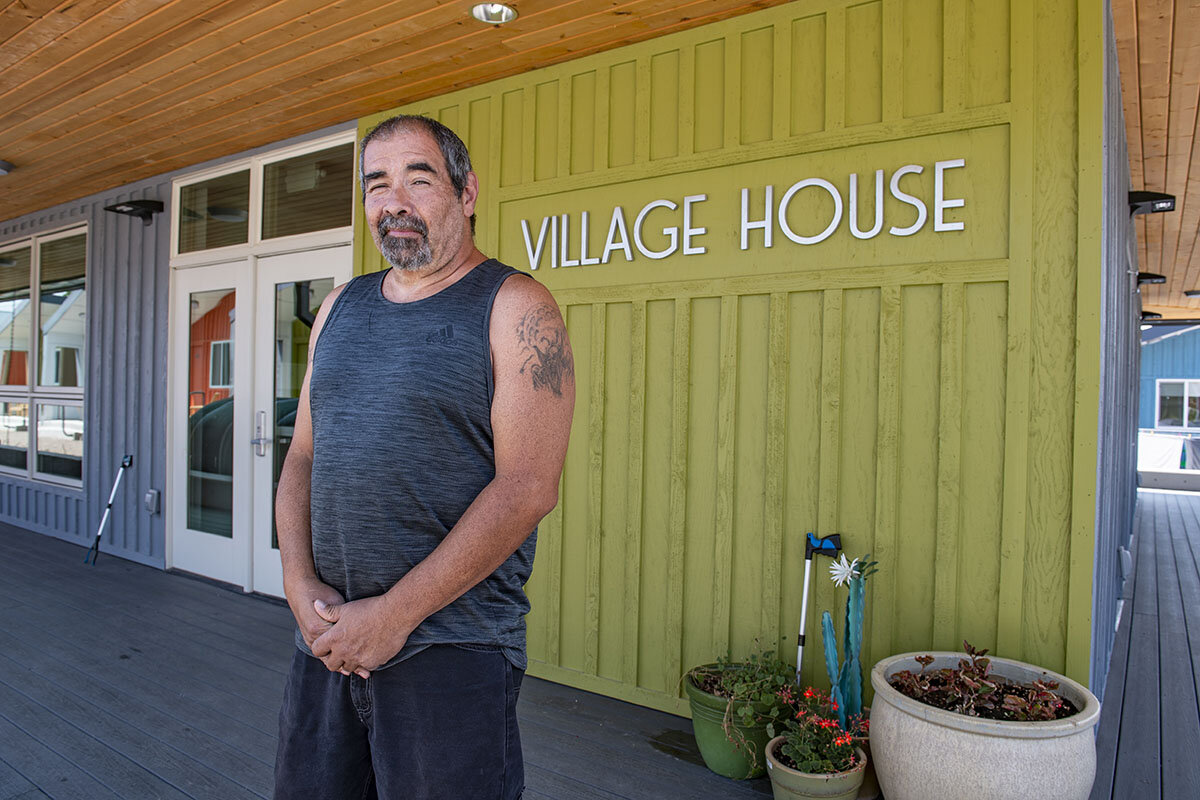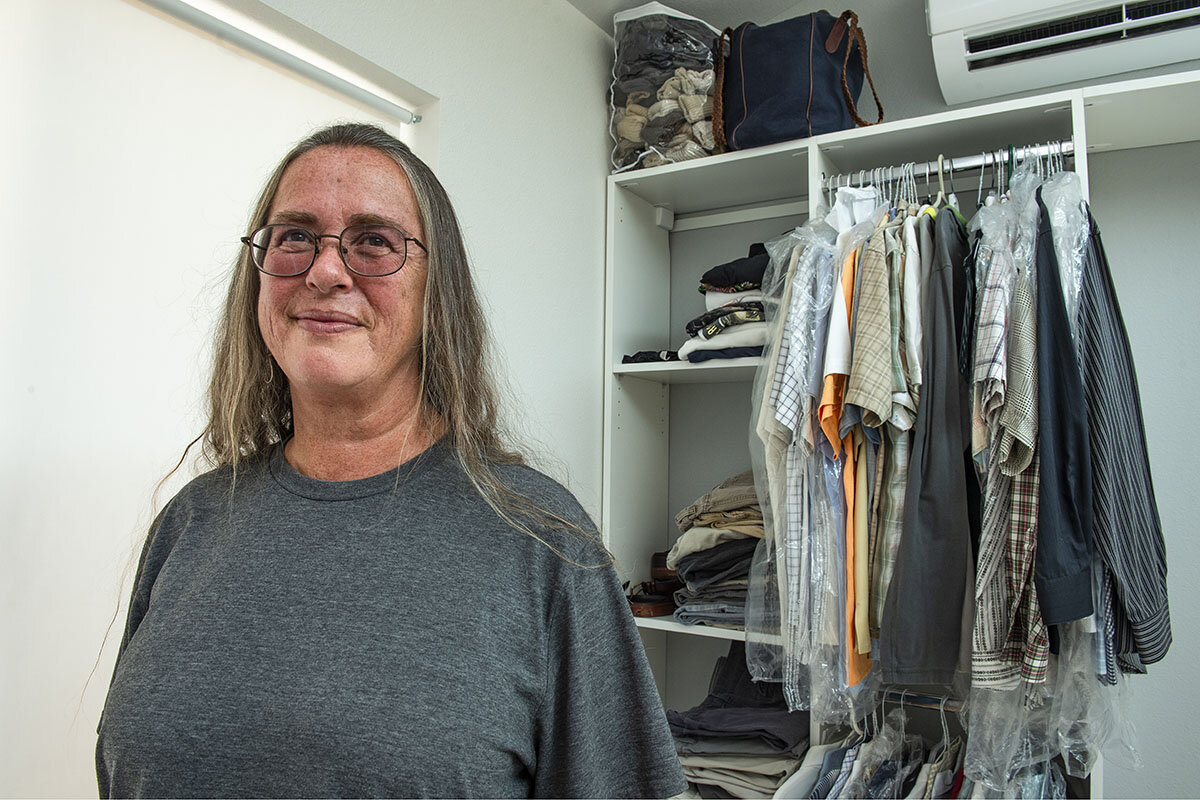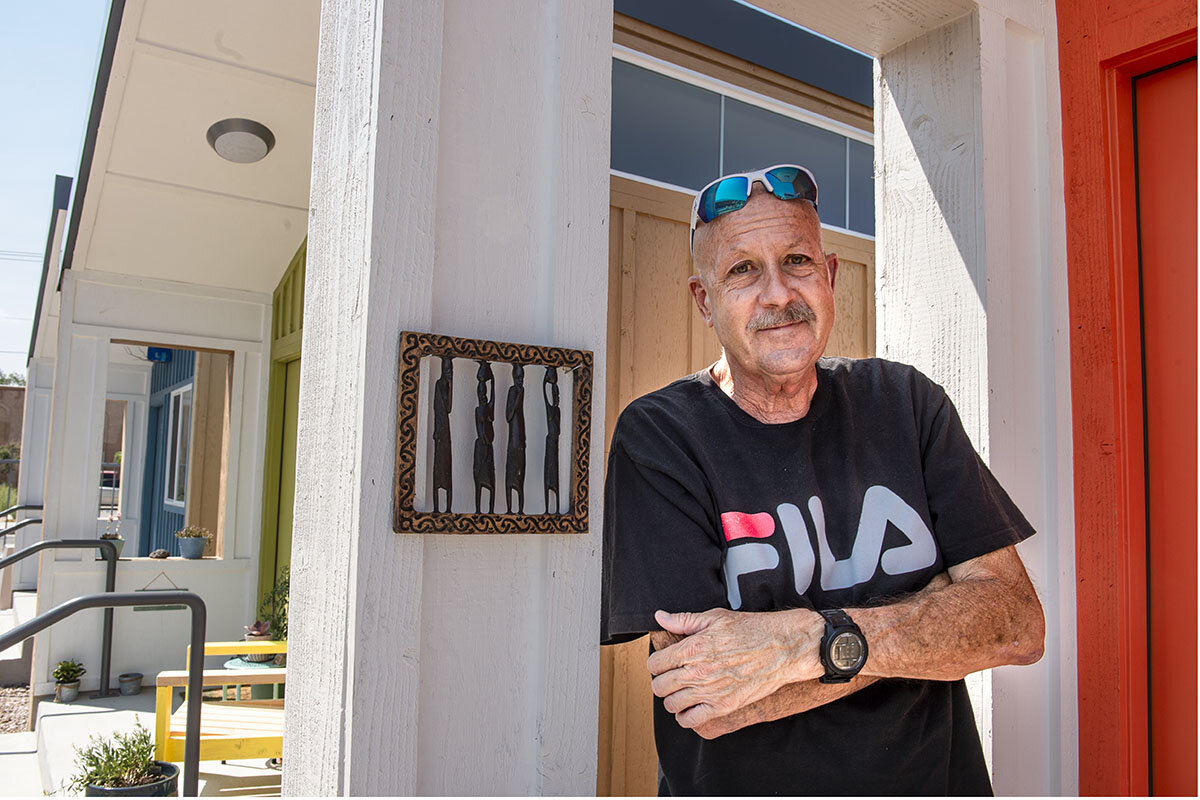Tiny Home Village offers path out of homelessness
Loading...
| Albuquerque, N.M.
What Henry Esquivel likes most about his new house is the blast of cold air it delivers when he walks in.
It’s a big change from the Ford F-150 he used to sleep in, where temperatures would sometimes reach 110 degrees. It’s more spacious too, despite his new house being just one room. And it comes with neighbors – all of whom, like him, recently experienced homelessness.
A few doors down is Mark Larusch. The father of three has potted plants and an Adirondack chair on his patio. A few doors further away is the woman whose large, black Labrador, Dottie, greets Mr. Esquivel excitedly every day.
Why We Wrote This
Having learned from other cities’ attempts to address homelessness, Albuquerque, New Mexico, has opened a village of tiny homes. It hopes fostering a sense of community will prepare residents for permanent housing.
“It’s not big, but I don’t need big,” he says. “It keeps me sane, it keeps me safe.”
The Tiny Home Village (THV) in Albuquerque opened in February, and he was one of the first people to move in. A pilot program funded by the local Bernalillo County, the THV hopes to provide Mr. Esquivel and his neighbors with the shelter and resources to help them complete the often bewildering transition from life on the streets to permanent housing.
The number of people experiencing homelessness has increased – and become increasingly visible – in cities around the country in recent years. Albuquerque is no exception.
In January 2020, before the pandemic, the ranks of the unhoused nationwide had grown 2.2% over 2019, the fourth consecutive year of increases. (The count includes the unsheltered, those living on the street, in cars, etc.; and the sheltered, those in shelters or transitional housing.) Due to COVID-19 complications, the January 2021 count of those experiencing homelessness was incomplete, but there’s no doubt homelessness increased during the pandemic. As a result, cities have been exploring new ways to provide shelter and services.
“We see the level of visible homelessness in a completely different state than we have” in the past, says Donald Whitehead, executive director of the National Coalition for the Homeless. “That’s really pushing people to look for new options, that are really old options.”
Albuquerque is relatively late in adopting tiny home villages, which have been established around the country over the past decade. Villages vary in size, amenities, and philosophies, but they all provide four walls and a door that locks (and the peace of mind that comes with that) in the short term, and in the long term a small, structured community that can equip residents to find – and keep – permanent homes.
Building on earlier examples
Albuquerque has looked to other tiny home villages for both inspiration and lessons learned.
Denver’s Beloved Community Village provided something of a cautionary tale: It had to relocate after two years because it had only a temporary permit for its original site. With that in mind and despite having trouble finding a location, the founders of the Albuquerque THV secured a 30-year lease on a lot owned by the Albuquerque Indian Center.
The main source of inspiration for Albuquerque is the Opportunity Village Eugene (OVE), in Oregon. Opened in 2013, it combines accommodations with access to social services and work opportunities.
“They already had so much in place to help us,” says Ilse Biel, resource manager for the Albuquerque THV.
What Albuquerque most wants to mimic is OVE’s self-governance model. The residents themselves are key players in deciding how the village runs day-to-day. That responsibility, dignity, and sense of community are invaluable in helping them make a sustainable transition from the streets, says Ms. Biel.
“We’re trying to give the villagers some tools that would stand them in really good stead once they do move out,” she adds.
Tent City to Tiny Home
Albuquerque’s THV occupies one acre on a sleepy block on the city’s southeast side. There are 30 stand-alone houses in the village, each with the same layout: bed, desk, two chairs, shelves, and closet space, as well as a front patio.
But villagers aren’t supposed to spend too much time in their new homes.
The real center of the community is meant to be the “Village House” at the heart of the campus, where residents can cook, do laundry, hold meetings, go to the library, and watch television. Nearby is a small community garden – with tomatoes, chilis, onions, and squash – as well as a picnic area, where trees are slowly growing to provide some natural shade.
The relatively spartan nature of the homes compared to the array of gathering spaces and chores – doing dishes, weeding, watering the garden, and cleaning the bathrooms, among other things – is intentional, says Ms. Biel.
When people experiencing homelessness move off the street, “they lose [their] community from the street,” says Ms. Biel. “It takes forever to forge a new community.”
“With this model we’re almost trying to force the issue,” she adds.
Nowhere was that street community more visible in Albuquerque than in “Tent City” six years ago. The informal homeless encampment sprang up by a rail yard near downtown. Campers chalked addresses for their tents on the curb, as if to declare it a community.
But tensions with neighbors and law enforcement arose, and Tent City lasted only a matter of months. Yet it sparked a debate that eventually led Debbie O’Malley, a Bernalillo County commissioner, and some of her colleagues to propose a tiny home village.
The public loved the idea and voted for two bond programs that provided nearly $3 million for the village. (Roughly $2 million more came in from other sources.) But then the pushback started. “When it came down to location,” says Commissioner O’Malley, “the message was: not in my back yard.”
Three years on, the criticism has not disappeared – particularly given how many tiny homes remain empty. Taxpayers paying $5 million to house so few “is a cost-prohibitive monument to poor use of public money,” the Albuquerque Journal editorial board wrote in late July.
But for the THV to be successful, it needs to be more than just a place where people can sleep in safety. It needs to be a functioning community so villagers can hold each other accountable and develop the physical, emotional, and financial stability they need to stay off the streets for good. Achieving that means starting with a fairly high bar.
Applicants are tested for drugs, must have been sober for 10 days, must be committed to recovery from any addiction or substance abuse issues, and must participate in maintaining the village. Of the eight people approved to live in the THV since February, two were asked to leave due to disruptive behavior.
The public are “overwhelmed with the amount of people experiencing homelessness ... not just as a city, as a country,” says Commissioner O’Malley. They “want to see more people off the street.”
“That’s understandable.” she adds. “But we have criteria. It’s not just ‘open the doors.’”
“They’re not alone”
Mr. Larusch used to run businesses and build houses, he says. But for the best part of two decades, he’s battled with depression, anxiety, and physical injuries as he bounced between shelters, rehab facilities, and the streets.
At the THV, he values both his independence and the community. He does his chores – as well as some other people's. “I hate to see messes,” he says.
Indeed, among the measures of success Ms. Biel looks for are signs that “they’re house-proud” – villagers “really getting upset about seeing a counter not wiped, a cigarette butt somewhere.”
It shows that they’re settled into the village, and at the midpoint of what she describes as a “stability curve.”
To help villagers move toward the endpoint of that curve – permanent housing – the THV provides access to an occupational therapist and psychiatric nurse, as well as volunteers who help residents with computer skills, résumé building, and mock interviews. Future plans include bringing micro-industries into the village so residents can start de facto small businesses in pottery, carpentry, and stonemasonry.
But patience is key for tiny home villages, advocates say.
“In many cases it’s not just about their lack of a home. There’s so many other issues involved,” says Mr. Whitehead from the National Coalition for the Homeless.
“It takes a village to help people overcome long-term homelessness,” he adds.
Those who eventually move on from the THV to permanent housing will continue to have access to the village and its services, but Ms. Biel hopes they’ll also become “navigators” to help current residents.
Mr. Larusch doesn’t know when he’ll be ready to leave, but he’s already begun to assume some “navigator” responsibilities.
“I try to help people out as much as I can. Mostly by sharing my story,” he says. “It maybe helps somebody out, and makes them feel like they’re not alone.”










